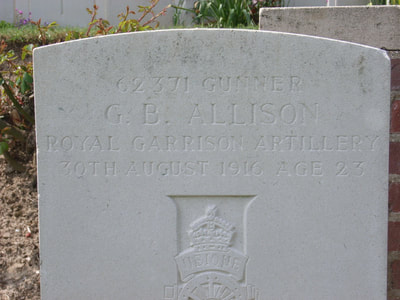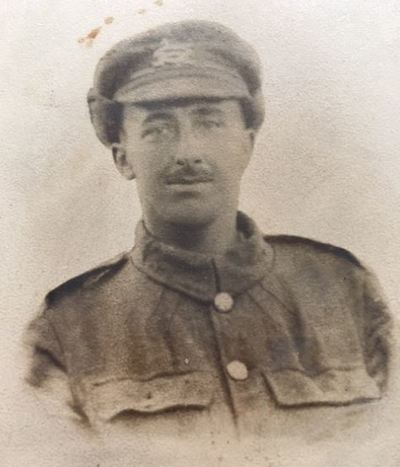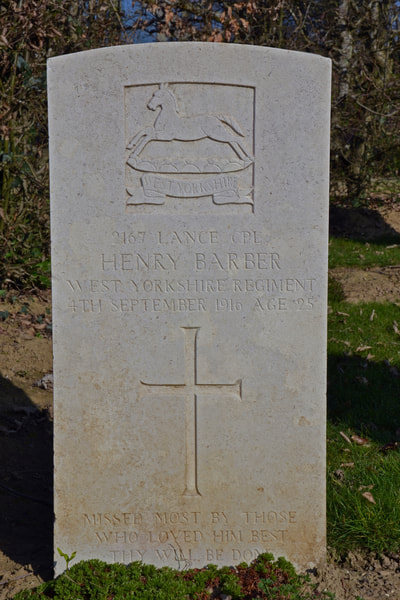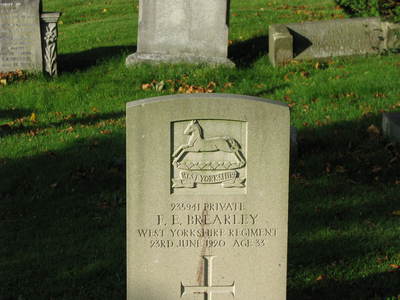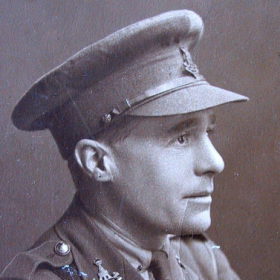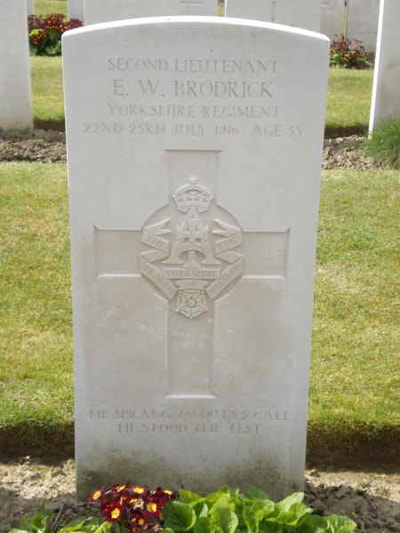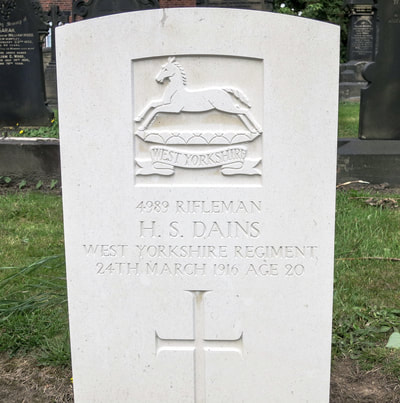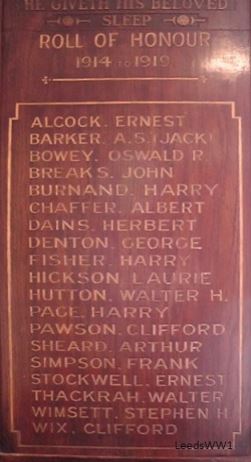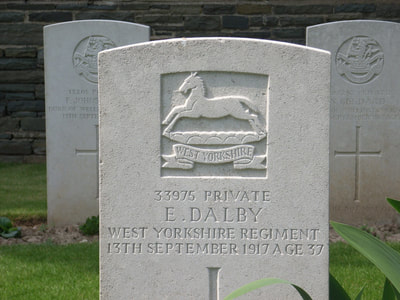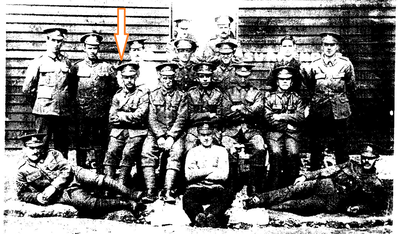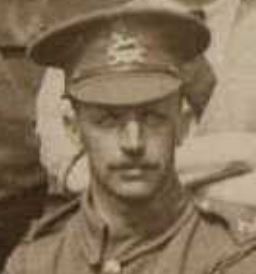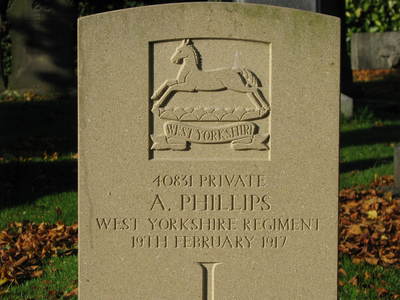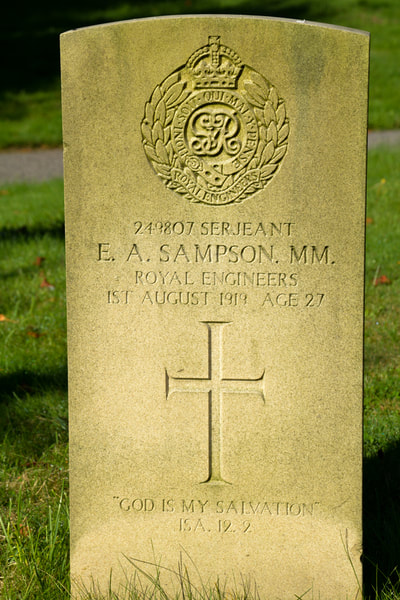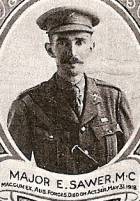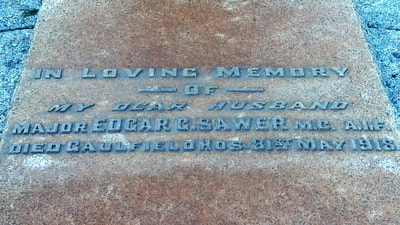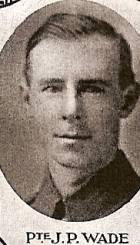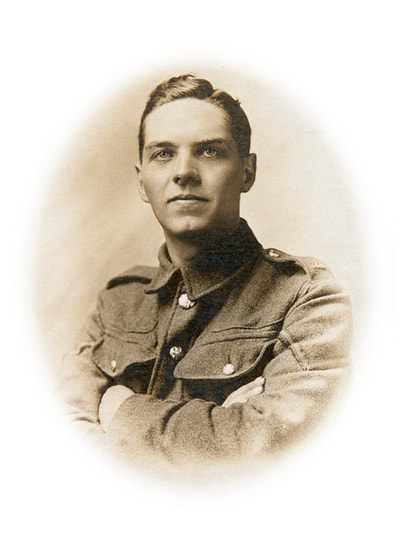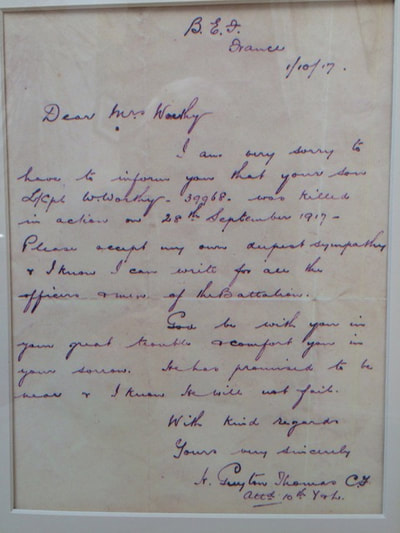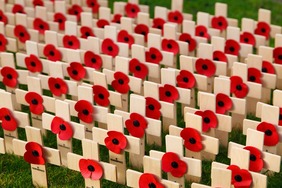
The Men Who Died in the War
Fifteen men associated with East Keswick who fought in the War had died by Armistice Day, and a further three died in the course of the following year. They are listed below in alphabetical order.
To see the caption for the photo, just hover your mouse over the image.
George Bertram Allison.
George was born in East Keswick in April 1894.
He was the youngest of three children of Edward Allison and Ada Preston who married in 1888. Edward was a market gardener and son of Jarvis who was also a market gardener who moved with his wife Martha and his family from east Leeds to Moor Lane in East Keswick in the 1860s.
Jarvis and Martha are buried in St Mary Magdalene churchyard.
In 1911 George and his brother were working as gardeners with their father Edward living in Plum Tree Cottage on Moor Lane.
George enlisted with the Royal Garrison Artillery in Leeds on the 30th of October 1915 with service number 62371 at the same time as what presumably was his friend Stephen Barrett who was a grocery warehouseman living on Main Street East Keswick and who had regimental number 62372. They were posted in November 1915 and joined the newly formed 142nd Siege Battery in June 1916.
Siege Batteries were equipped with heavy howitzers, sending large calibre high explosive shells in high trajectory and were most often employed in destroying or neutralising the enemy artillery, as well as putting destructive fire down on strongpoints, dumps, store, roads and railways behind enemy lines.
The 142nd siege battery were first overseas on 9th August 1916 and were immediately involved in the Battle of the Somme. George must have been injured within days of arriving as he died of his wounds, aged 23, on the 30th August 1916 at the dressing station of Dernancourt to which he would have been taken by field ambulance.
George is buried in the Dernancourt communal cemetery extension.
Stephen Barrett went on to win the Military Medal for “great gallantry and devotion to duty on 5th April 1918” and lived in Whitegates for many years until his death in 1982.
Both their parents lived in Moor Gardens until their deaths in the 1930s and his sister Marion, having married a market gardener John Brooks, remained in Moor Gardens until at least the 1960s.
George was born in East Keswick in April 1894.
He was the youngest of three children of Edward Allison and Ada Preston who married in 1888. Edward was a market gardener and son of Jarvis who was also a market gardener who moved with his wife Martha and his family from east Leeds to Moor Lane in East Keswick in the 1860s.
Jarvis and Martha are buried in St Mary Magdalene churchyard.
In 1911 George and his brother were working as gardeners with their father Edward living in Plum Tree Cottage on Moor Lane.
George enlisted with the Royal Garrison Artillery in Leeds on the 30th of October 1915 with service number 62371 at the same time as what presumably was his friend Stephen Barrett who was a grocery warehouseman living on Main Street East Keswick and who had regimental number 62372. They were posted in November 1915 and joined the newly formed 142nd Siege Battery in June 1916.
Siege Batteries were equipped with heavy howitzers, sending large calibre high explosive shells in high trajectory and were most often employed in destroying or neutralising the enemy artillery, as well as putting destructive fire down on strongpoints, dumps, store, roads and railways behind enemy lines.
The 142nd siege battery were first overseas on 9th August 1916 and were immediately involved in the Battle of the Somme. George must have been injured within days of arriving as he died of his wounds, aged 23, on the 30th August 1916 at the dressing station of Dernancourt to which he would have been taken by field ambulance.
George is buried in the Dernancourt communal cemetery extension.
Stephen Barrett went on to win the Military Medal for “great gallantry and devotion to duty on 5th April 1918” and lived in Whitegates for many years until his death in 1982.
Both their parents lived in Moor Gardens until their deaths in the 1930s and his sister Marion, having married a market gardener John Brooks, remained in Moor Gardens until at least the 1960s.
Samuel Asquith
Samuel, or Sam as he was known, was born in Cleckheaton in 1890.
He was the youngest of six children of John Asquith and Mary Cawthorn who were married in 1870. John was a mason’s labourer but originally he and a number of his family were textile workers. Sam’s mother Mary died in 1893 and in 1896 John remarried Eliza Jane Butler. In 1908 John also died, so Sam had lost both his parents by the time he was 18.
In 1911 Sam seems to have been living alone in Cleckheaton but by 1913 he was a grocer’s assistant in East Keswick and on 14th June 1913 he married Annie Kinghorn, a domestic servant, from Victoria Street Wetherby whose family were from Linton.
George enlisted at Wetherby with service number 28072 in the 12th battalion of the West Yorkshire regiment which was formed on 16 September 1914. In September 1915 they landed at Le Havre and marched across France to act as reserve for the British attack on Loos on 26th September, suffering heavy casualties. In 1916 they took part in a number of actions before being involved in the battle for Delville Wood, part of the Somme, starting July 15th. At 10pm on the 17th August a surprise British attack was launched, without preliminary bombardment, but they were forced to retire owing to the heavy rifle and machine gun fire. 15 were killed, 135 wounded and 11 were missing of whom Sam was one.
Sam, aged 26, is named on the Thiepval Memorial in the Somme which commemorates over 72,000 men who died on the Somme with no known grave.
Annie’s brother Harold named his second son Samuel Asquith Kinghorn when he was born in 1919 and Samuel lived in Wetherby until 1980.
Annie remained in Victoria Street Wetherby until 1921 but it is not clear what happened to her after that.
Samuel, or Sam as he was known, was born in Cleckheaton in 1890.
He was the youngest of six children of John Asquith and Mary Cawthorn who were married in 1870. John was a mason’s labourer but originally he and a number of his family were textile workers. Sam’s mother Mary died in 1893 and in 1896 John remarried Eliza Jane Butler. In 1908 John also died, so Sam had lost both his parents by the time he was 18.
In 1911 Sam seems to have been living alone in Cleckheaton but by 1913 he was a grocer’s assistant in East Keswick and on 14th June 1913 he married Annie Kinghorn, a domestic servant, from Victoria Street Wetherby whose family were from Linton.
George enlisted at Wetherby with service number 28072 in the 12th battalion of the West Yorkshire regiment which was formed on 16 September 1914. In September 1915 they landed at Le Havre and marched across France to act as reserve for the British attack on Loos on 26th September, suffering heavy casualties. In 1916 they took part in a number of actions before being involved in the battle for Delville Wood, part of the Somme, starting July 15th. At 10pm on the 17th August a surprise British attack was launched, without preliminary bombardment, but they were forced to retire owing to the heavy rifle and machine gun fire. 15 were killed, 135 wounded and 11 were missing of whom Sam was one.
Sam, aged 26, is named on the Thiepval Memorial in the Somme which commemorates over 72,000 men who died on the Somme with no known grave.
Annie’s brother Harold named his second son Samuel Asquith Kinghorn when he was born in 1919 and Samuel lived in Wetherby until 1980.
Annie remained in Victoria Street Wetherby until 1921 but it is not clear what happened to her after that.
Henry Barber
Henry was born in East Keswick in 1891.
He was the third of four children of Thomas Edmund Barber and Emma Wright who were married in 1888. The Barber family had been farming in the Harewood area and notably Dunkeswick for over 100 years. The Wright family farmed in the west end of East Keswick and lived in Wright’s Cottage. Thomas himself was recorded farming at West End Farm in East Keswick in 1891.
In 1901 the family including, ten year old Henry were still at West End Farm but by 1911 Henry, now calling himself Harry, had left home and was boarding and working as a grocer’s apprentice with Harry Evans and family in Harewood.
Henry enlisted in Harrogate around August 1914 in 1/5th battalion of the West Yorkshire Regiment territorial force. His service number was 2167. After landing in Boulogne in April 1915 the battalion was involved in various actions on the Western Front. At some point Henry was promoted to Lance Ccorporal. The battalion took part in the first two weeks of the Anglo French offensive at the Somme, known as the battle of Albert in early July 1916, and then the battle of Pozieres Ridge from 23rd July until 3rd September. It must have been during this time that Henry was injured as he was taken by field ambulance to the 49th casualty clearing station at Contay where he died, aged 25, from his wounds on 4th September 1916.
Henry is buried in the Contay British Cemetery with over 1,100 others.
Henry’s younger brother Francis also enlisted in the army. He survived the war and returned to live in Burdett Cottages. Other family also remained in East Keswick after the war, his brother William lived in Ivy Grange on Moor Lane until his death in 1964.
There is a memorial for Henry on the gravestone of his parents in St Mary Magdalene churchyard.
Henry was born in East Keswick in 1891.
He was the third of four children of Thomas Edmund Barber and Emma Wright who were married in 1888. The Barber family had been farming in the Harewood area and notably Dunkeswick for over 100 years. The Wright family farmed in the west end of East Keswick and lived in Wright’s Cottage. Thomas himself was recorded farming at West End Farm in East Keswick in 1891.
In 1901 the family including, ten year old Henry were still at West End Farm but by 1911 Henry, now calling himself Harry, had left home and was boarding and working as a grocer’s apprentice with Harry Evans and family in Harewood.
Henry enlisted in Harrogate around August 1914 in 1/5th battalion of the West Yorkshire Regiment territorial force. His service number was 2167. After landing in Boulogne in April 1915 the battalion was involved in various actions on the Western Front. At some point Henry was promoted to Lance Ccorporal. The battalion took part in the first two weeks of the Anglo French offensive at the Somme, known as the battle of Albert in early July 1916, and then the battle of Pozieres Ridge from 23rd July until 3rd September. It must have been during this time that Henry was injured as he was taken by field ambulance to the 49th casualty clearing station at Contay where he died, aged 25, from his wounds on 4th September 1916.
Henry is buried in the Contay British Cemetery with over 1,100 others.
Henry’s younger brother Francis also enlisted in the army. He survived the war and returned to live in Burdett Cottages. Other family also remained in East Keswick after the war, his brother William lived in Ivy Grange on Moor Lane until his death in 1964.
There is a memorial for Henry on the gravestone of his parents in St Mary Magdalene churchyard.
Frederick Eustace Brearley
Frederick was born in Leeds in 1894 and baptised in Chapel Allerton.
He was the third of four children of Arthur Brearley and Mary Talley. Both were in Headingley in 1881, Arthur working in the drapery business and Mary, who originated from Tiverton, working as milliner’s manager before marrying in 1883. Arthur and Mary stayed in Headingley and raised their four boys over the next 30 years.
By 1911 Frederick had left home and married Gladys Lee and subsequently they moved to Beck Cottage in East Keswick and had three children Joan, Margaret and Thomas over the next few years.
Frederick enlisted in Harrogate in September 1915 in 3/1st battalion of the Yorkshire Hussars cavalry regiment having previously been in the territorial regiment for two years. His service number was 3362. In March 1916 he was promoted to Lance Corporal prior to posting with the 1/1st battalion in July 1916. The regiment was present at the battle of Arras in April 1917, but in August 1917 the bulk of the regiment was transferred to the 9th battalion West Yorkshire infantry regiment, including Frederick as a private with service number 235941. The battalion saw much hard fighting including the battle of Passchendaele. Frederick was hospitalised three times during his service, firstly with scabies, secondly with a knee injury and finally with gingivitis, otherwise known as trench mouth.
On demobilization in September 1919 Frederick signed a form stating “I do not claim to be suffering from any disability due to military service” however it seems that he was suffering from the effects of being in the trenches for more than two years.
Frederick returned to live in Beck Cottage with his family, but in less than a year he passed away, aged 33, on 23rd June 1920.
Frederick’s widow, Gladys remained in East Keswick until remarrying and moving to Roundhay in 1930s but their children were still in the village up to 2000.
Two of Frederick’s brothers emigrated to Canada before the war and regrettably his younger brother Ernest was killed whilst serving with the 8th battalion Canadian Infantry in September 1916.
There is a Commonwealth war grave for Frederick in St Mary Magdalene churchyard.
Frederick was born in Leeds in 1894 and baptised in Chapel Allerton.
He was the third of four children of Arthur Brearley and Mary Talley. Both were in Headingley in 1881, Arthur working in the drapery business and Mary, who originated from Tiverton, working as milliner’s manager before marrying in 1883. Arthur and Mary stayed in Headingley and raised their four boys over the next 30 years.
By 1911 Frederick had left home and married Gladys Lee and subsequently they moved to Beck Cottage in East Keswick and had three children Joan, Margaret and Thomas over the next few years.
Frederick enlisted in Harrogate in September 1915 in 3/1st battalion of the Yorkshire Hussars cavalry regiment having previously been in the territorial regiment for two years. His service number was 3362. In March 1916 he was promoted to Lance Corporal prior to posting with the 1/1st battalion in July 1916. The regiment was present at the battle of Arras in April 1917, but in August 1917 the bulk of the regiment was transferred to the 9th battalion West Yorkshire infantry regiment, including Frederick as a private with service number 235941. The battalion saw much hard fighting including the battle of Passchendaele. Frederick was hospitalised three times during his service, firstly with scabies, secondly with a knee injury and finally with gingivitis, otherwise known as trench mouth.
On demobilization in September 1919 Frederick signed a form stating “I do not claim to be suffering from any disability due to military service” however it seems that he was suffering from the effects of being in the trenches for more than two years.
Frederick returned to live in Beck Cottage with his family, but in less than a year he passed away, aged 33, on 23rd June 1920.
Frederick’s widow, Gladys remained in East Keswick until remarrying and moving to Roundhay in 1930s but their children were still in the village up to 2000.
Two of Frederick’s brothers emigrated to Canada before the war and regrettably his younger brother Ernest was killed whilst serving with the 8th battalion Canadian Infantry in September 1916.
There is a Commonwealth war grave for Frederick in St Mary Magdalene churchyard.
Eric William Brodrick
Eric was born in Farnley in1881.
He was the youngest of five children of the reverend Francis Brodrick from Macclesfield and Jane Wood from Birmingham who married in 1872.
Having served in various parishes Francis and Jane with four children moved to Farnley in south west Leeds in 1880 which is where Eric was born one year later.
Eric was educated in Otley, Roundhay and Bradford Grammar School. He went to the Philippines in 1902 where he worked as a Province Agent for the shippers and insurers Messrs Smith Ball and Co who are still trading today. He was home on leave when war broke out in August 1914.
He immediately joined the Royal Fusiliers Public Schools Battalion and transferred to the Inns of Court Officer Training Corps after a month. He was commissioned to 2nd lieutenant with the 5th territorial battalion of the Yorkshire Regiment in March 1915
Whilst on leave Eric married Margaret Lucie Moon, daughter of the grocer/entrepreneur George Henry Moon, in East Keswick on April 17th 1915.
In November 1915 Eric was promoted to lieutenant and was posted to France in March 1916. He was injured and sent home before returning to his battalion. In spring of 1916 the battalion were at various locations around the Ypres Salient including actions at the Bluff and Hill 60.
They took part in a large attack near Kemmel on an enemy mine crater on July 10th following which Eric led a night patrol to reconnoitre the German lines. The patrol came under heavy fire and Eric was wounded and captured. He died from his wounds in enemy hands around 23rd of July 1916, aged 35. Eric was buried by the enemy in one of their battlefield cemeteries, but today his grave lies in Larch Wood Cemetery at Zillebeke to the south east of Ypres, his body being one of many that were brought in during clearances after the war.
His colonel later wrote to his parents, "The whole battalion, officers and men sorrow with you. We all loved your son and his men would have done anything for him".
A fellow officer added “He was very much liked by everybody, officers and men, and set a splendid example by his coolness and courage under the most trying circumstances”.
Eric Brodrick's daughter, Erica, was born after his death in September 1916.
Although a number of the Moon family remained in East Keswick for some years, Margaret and Erica soon moved to Morecambe and later to Denbighshire. Erica died in 2003.
Eric’s brother-in-law, Henry Moon, was a lieutenant in the territorial battalion of the Yorkshire Light Infantry and survived the war only to die in Brighton in 1923.
Eric was born in Farnley in1881.
He was the youngest of five children of the reverend Francis Brodrick from Macclesfield and Jane Wood from Birmingham who married in 1872.
Having served in various parishes Francis and Jane with four children moved to Farnley in south west Leeds in 1880 which is where Eric was born one year later.
Eric was educated in Otley, Roundhay and Bradford Grammar School. He went to the Philippines in 1902 where he worked as a Province Agent for the shippers and insurers Messrs Smith Ball and Co who are still trading today. He was home on leave when war broke out in August 1914.
He immediately joined the Royal Fusiliers Public Schools Battalion and transferred to the Inns of Court Officer Training Corps after a month. He was commissioned to 2nd lieutenant with the 5th territorial battalion of the Yorkshire Regiment in March 1915
Whilst on leave Eric married Margaret Lucie Moon, daughter of the grocer/entrepreneur George Henry Moon, in East Keswick on April 17th 1915.
In November 1915 Eric was promoted to lieutenant and was posted to France in March 1916. He was injured and sent home before returning to his battalion. In spring of 1916 the battalion were at various locations around the Ypres Salient including actions at the Bluff and Hill 60.
They took part in a large attack near Kemmel on an enemy mine crater on July 10th following which Eric led a night patrol to reconnoitre the German lines. The patrol came under heavy fire and Eric was wounded and captured. He died from his wounds in enemy hands around 23rd of July 1916, aged 35. Eric was buried by the enemy in one of their battlefield cemeteries, but today his grave lies in Larch Wood Cemetery at Zillebeke to the south east of Ypres, his body being one of many that were brought in during clearances after the war.
His colonel later wrote to his parents, "The whole battalion, officers and men sorrow with you. We all loved your son and his men would have done anything for him".
A fellow officer added “He was very much liked by everybody, officers and men, and set a splendid example by his coolness and courage under the most trying circumstances”.
Eric Brodrick's daughter, Erica, was born after his death in September 1916.
Although a number of the Moon family remained in East Keswick for some years, Margaret and Erica soon moved to Morecambe and later to Denbighshire. Erica died in 2003.
Eric’s brother-in-law, Henry Moon, was a lieutenant in the territorial battalion of the Yorkshire Light Infantry and survived the war only to die in Brighton in 1923.
Herbert Sanderson Dains
Herbert was born in Sicklinghall in 1895.
He was the eldest of three sons of Joseph Dains and Margaret Harrison who were married in 1894. Herbert’s father and grandfather were both plumbers who had their own business in the Burley area of Leeds.
It seems that the family were Baptists, a new church having been built in Burley Road in 1877.
In the 1911 census Herbert aged 15 is shown as working on “hats and caps” presumably in a mill.
Shortly after this family moved to East Keswick whilst maintaining their business in Burley. They lived at the corner of Whitegates, Lumby lane and Main Street which later became known as called “Dains Corner” as the family had shops on both sides of the road.
Herbert enlisted as a rifleman in the 3/7th territorial battalion of the West Yorkshire regiment which was formed in Leeds on 25th March 1915. His service number was 4989. Later in the year, in common with many others, the battalion moved to Clipstone Camp.
Clipstone Camp was a massive army camp of wooden huts which was built near Mansfield. While this camp was just one of those built to train the men of Kitchener's New Army, it is believed to be the largest. Clipstone Camp could hold upwards of 30,000 men the first of which arrived in May 1915. The once peaceful countryside was alive with soldiers digging trenches, practising on rifle ranges and stirring up the dust on country lanes as they went on training marches.
It was whilst here on 24th March 1916 that Herbert passed away aged 20.
He is buried in New Wortley Cemetery and is also named on the WW1 memorial board in South Parade Baptist Church, Headingley.
The extended family remained in East Keswick until at least the 1940s.
Herbert was born in Sicklinghall in 1895.
He was the eldest of three sons of Joseph Dains and Margaret Harrison who were married in 1894. Herbert’s father and grandfather were both plumbers who had their own business in the Burley area of Leeds.
It seems that the family were Baptists, a new church having been built in Burley Road in 1877.
In the 1911 census Herbert aged 15 is shown as working on “hats and caps” presumably in a mill.
Shortly after this family moved to East Keswick whilst maintaining their business in Burley. They lived at the corner of Whitegates, Lumby lane and Main Street which later became known as called “Dains Corner” as the family had shops on both sides of the road.
Herbert enlisted as a rifleman in the 3/7th territorial battalion of the West Yorkshire regiment which was formed in Leeds on 25th March 1915. His service number was 4989. Later in the year, in common with many others, the battalion moved to Clipstone Camp.
Clipstone Camp was a massive army camp of wooden huts which was built near Mansfield. While this camp was just one of those built to train the men of Kitchener's New Army, it is believed to be the largest. Clipstone Camp could hold upwards of 30,000 men the first of which arrived in May 1915. The once peaceful countryside was alive with soldiers digging trenches, practising on rifle ranges and stirring up the dust on country lanes as they went on training marches.
It was whilst here on 24th March 1916 that Herbert passed away aged 20.
He is buried in New Wortley Cemetery and is also named on the WW1 memorial board in South Parade Baptist Church, Headingley.
The extended family remained in East Keswick until at least the 1940s.
Ernest Dalby
Ernest was born in July 1880
He was the ninth of eleven children of John Dalby and Sarah Kilvington who married in 1862 and who spent most of their married life in Sicklinghall. Both were descendants of agricultural labourers in the area, John himself was an agricultural labourer whilst Sarah was a laundress.
Ernest, also an agricultural labourer, was married to Flora Mary Mawson, the daughter of a farmer from Barsey-cum-Rigton. In 1911 Ernest and Flora were living in East Keswick.
At the end of September 1914, in York, Ernest enlisted in the 2/5th territorial battalion of the West Yorkshire regiment with service number 33975. The Battalion spent a couple of years in various locations in England before finally landing at Le Havre in January 1917.
They took part in operations on the Ancre in February 1917, and the Arras offensive between April and June. During September the battalion was in the Favreuil area of Pas-de Calais working on trenches during a period of fine weather. On the 12th September the commander wrote that they considered themselves “masters of the alleged no man’s land” but on the 13th the Germans put up a barrage and raided the British trenches. Although the raid failed six of the 2/6th battalion and two of the 2/5th battalion were killed of whom Ernest, aged 37, was one.
He is buried in Favreuil British cemetery along with 400 others.
His widow, Flora, and children remained in East Keswick for many years.
Ernest was born in July 1880
He was the ninth of eleven children of John Dalby and Sarah Kilvington who married in 1862 and who spent most of their married life in Sicklinghall. Both were descendants of agricultural labourers in the area, John himself was an agricultural labourer whilst Sarah was a laundress.
Ernest, also an agricultural labourer, was married to Flora Mary Mawson, the daughter of a farmer from Barsey-cum-Rigton. In 1911 Ernest and Flora were living in East Keswick.
At the end of September 1914, in York, Ernest enlisted in the 2/5th territorial battalion of the West Yorkshire regiment with service number 33975. The Battalion spent a couple of years in various locations in England before finally landing at Le Havre in January 1917.
They took part in operations on the Ancre in February 1917, and the Arras offensive between April and June. During September the battalion was in the Favreuil area of Pas-de Calais working on trenches during a period of fine weather. On the 12th September the commander wrote that they considered themselves “masters of the alleged no man’s land” but on the 13th the Germans put up a barrage and raided the British trenches. Although the raid failed six of the 2/6th battalion and two of the 2/5th battalion were killed of whom Ernest, aged 37, was one.
He is buried in Favreuil British cemetery along with 400 others.
His widow, Flora, and children remained in East Keswick for many years.
Charles Hardisty
Charles was born in East Keswick in 1878.
He was the youngest of four children of John Hardisty and Mary Ann Hartley who married in 1868. John, who was born in Thorner, was initially an agricultural labourer before becoming a highways labourer working for the council; he was also a church warden. Mary was the daughter of an agricultural labouring family from East Keswick.
The family lived in West End of East Keswick but unfortunately Mary died in 1882 when Charles was only four. John then married Margaret McGowan, and they had a further two children. Unfortunately Margaret also died in 1890, so John then seems to have brought the family up on his own. In 1901 Charles was a domestic gardener and in 1911 he was a house servant. In 1913 his father John also died.
Charles was living with his sister Annie in Burdett Cottage.
Charles enlisted in the 2/6th territorial battalion of the West Yorkshire Regiment which was formed in September 1914. His service number was 5878. The Battalion spent a couple of years in various locations in England before finally landing at Le Havre in January 2017 at which time he would also have received new service number of 242268.
The 2/6th served alongside the 2/5th in operations on the Ancre in February, the Arras offensive between April and June and Favreuil in September, so Charles may well have met Ernest Dalby who was also from East Keswick and who was killed on 13th September.
In November 2017 the battalion took part in the Cambrai operations before being disbanded on 31st January 1918.
Charles spent some time with the 252 tunnelling company of Royal Engineers and then the 3rd Entrenching Battalion in early 1918 before joining the regular 1st battalion by the end of April.
In September 2018 the 1st battalion were east of Amiens and on the 17th September they attacked enemy positions near Holnon village but suffered heavy casualties from machine gun fire. 17 were killed and 86 were missing, of which Charles would have been one.
Charles, aged 40, is remembered on the memorial at Vis-en-Artois together with over 9000 other men.
Charles’s brother Herbert fought with the Royal Garrison Artillery and survived to return to live in 9 Brooklands. Other family members remained in East Keswick, notably in Windy Ridge.
Charles was born in East Keswick in 1878.
He was the youngest of four children of John Hardisty and Mary Ann Hartley who married in 1868. John, who was born in Thorner, was initially an agricultural labourer before becoming a highways labourer working for the council; he was also a church warden. Mary was the daughter of an agricultural labouring family from East Keswick.
The family lived in West End of East Keswick but unfortunately Mary died in 1882 when Charles was only four. John then married Margaret McGowan, and they had a further two children. Unfortunately Margaret also died in 1890, so John then seems to have brought the family up on his own. In 1901 Charles was a domestic gardener and in 1911 he was a house servant. In 1913 his father John also died.
Charles was living with his sister Annie in Burdett Cottage.
Charles enlisted in the 2/6th territorial battalion of the West Yorkshire Regiment which was formed in September 1914. His service number was 5878. The Battalion spent a couple of years in various locations in England before finally landing at Le Havre in January 2017 at which time he would also have received new service number of 242268.
The 2/6th served alongside the 2/5th in operations on the Ancre in February, the Arras offensive between April and June and Favreuil in September, so Charles may well have met Ernest Dalby who was also from East Keswick and who was killed on 13th September.
In November 2017 the battalion took part in the Cambrai operations before being disbanded on 31st January 1918.
Charles spent some time with the 252 tunnelling company of Royal Engineers and then the 3rd Entrenching Battalion in early 1918 before joining the regular 1st battalion by the end of April.
In September 2018 the 1st battalion were east of Amiens and on the 17th September they attacked enemy positions near Holnon village but suffered heavy casualties from machine gun fire. 17 were killed and 86 were missing, of which Charles would have been one.
Charles, aged 40, is remembered on the memorial at Vis-en-Artois together with over 9000 other men.
Charles’s brother Herbert fought with the Royal Garrison Artillery and survived to return to live in 9 Brooklands. Other family members remained in East Keswick, notably in Windy Ridge.
Thomas Edwin Johnson
Thomas was born in East Keswick in 1887.
He was the fourth of five children of John Richard Johnson and Mary Lee who married in 1879. John was born in East Keswick, the son of a family farming over 100 acres in West End. John himself became a farmer and the family lived in Moor Cottages and West End.
In 1911 Thomas was a domestic gardener boarding with the Young family in Shadwell, which is also where in 1913 he married Annie Elizabeth Walton from Newark.
His mother Mary died in 1915.
Thomas enlisted in Leeds in the 1st battalion of the West Yorkshire Regiment. His service number was 33055.
In early spring 1917 the regiment was in Loos in northern France. The battalion were training at the end of February and then entered the trenches on 7th of March. Whilst mostly quiet over the next three weeks there was occasional shelling and a hostile raid with a number of soldiers wounded. Thomas was one of these.
He was evacuated back to England but unfortunately died of his wounds, aged 30, in Manchester General Hospital on 7th April 1917.
There is a Commonwealth War Grave for Thomas in St. Mary Magdalene churchyard.
Thomas’s brother, John, enlisted and survived the war.
It seems that Thomas’s widow Annie may have returned to Newark but his father John remained in East Keswick until his death in 1925.
Thomas was born in East Keswick in 1887.
He was the fourth of five children of John Richard Johnson and Mary Lee who married in 1879. John was born in East Keswick, the son of a family farming over 100 acres in West End. John himself became a farmer and the family lived in Moor Cottages and West End.
In 1911 Thomas was a domestic gardener boarding with the Young family in Shadwell, which is also where in 1913 he married Annie Elizabeth Walton from Newark.
His mother Mary died in 1915.
Thomas enlisted in Leeds in the 1st battalion of the West Yorkshire Regiment. His service number was 33055.
In early spring 1917 the regiment was in Loos in northern France. The battalion were training at the end of February and then entered the trenches on 7th of March. Whilst mostly quiet over the next three weeks there was occasional shelling and a hostile raid with a number of soldiers wounded. Thomas was one of these.
He was evacuated back to England but unfortunately died of his wounds, aged 30, in Manchester General Hospital on 7th April 1917.
There is a Commonwealth War Grave for Thomas in St. Mary Magdalene churchyard.
Thomas’s brother, John, enlisted and survived the war.
It seems that Thomas’s widow Annie may have returned to Newark but his father John remained in East Keswick until his death in 1925.
William Stanley Johnson
William was born in Meanwood in 1897.
He was the fifth of eight children of Herbert Johnson and Lucie Ann Campbell who married in 1887. Herbert was born in Wortley, Leeds in 1863 and he was a joiner /cabinet maker living in various parts of Leeds before moving with his family to Shadwell in 1900, and by 1911 they were in West End, East Keswick.
William enlisted in Wetherby around August 1914 in the 1/5th battalion of the West Yorkshire Regiment territorial force. His service number was 1630.
After landing in Boulogne in April 1915 the battalion were involved in various actions on the Western Front. The battalion took part in the first two weeks of the Anglo French offensive at the Somme and the battle of Pozieres ridge from July 2016. On the 27th September they were involved in the attack on the Schwaben Redoubt which was a German strong point near the village of Thiepval, overlooking the River Ancre. It consisted of a mass of machine-gun emplacements, trenches and dug-outs.
The formation was in daylight, in the open under cover of shell holes and under considerable rifle fire and shelling and although the mission was a success there were 16 casualties. William died, aged 19, on this day.
William is named on the Thiepval Memorial in the Somme which commemorates over 72,000 men who died at the Somme with no known grave.
William’s brother, Frank, fought with the 3rd West Riding Brigade and survived. William’s parents and siblings remained in East Keswick after the war, initially in Mount Pleasant and later South Bank.
William was born in Meanwood in 1897.
He was the fifth of eight children of Herbert Johnson and Lucie Ann Campbell who married in 1887. Herbert was born in Wortley, Leeds in 1863 and he was a joiner /cabinet maker living in various parts of Leeds before moving with his family to Shadwell in 1900, and by 1911 they were in West End, East Keswick.
William enlisted in Wetherby around August 1914 in the 1/5th battalion of the West Yorkshire Regiment territorial force. His service number was 1630.
After landing in Boulogne in April 1915 the battalion were involved in various actions on the Western Front. The battalion took part in the first two weeks of the Anglo French offensive at the Somme and the battle of Pozieres ridge from July 2016. On the 27th September they were involved in the attack on the Schwaben Redoubt which was a German strong point near the village of Thiepval, overlooking the River Ancre. It consisted of a mass of machine-gun emplacements, trenches and dug-outs.
The formation was in daylight, in the open under cover of shell holes and under considerable rifle fire and shelling and although the mission was a success there were 16 casualties. William died, aged 19, on this day.
William is named on the Thiepval Memorial in the Somme which commemorates over 72,000 men who died at the Somme with no known grave.
William’s brother, Frank, fought with the 3rd West Riding Brigade and survived. William’s parents and siblings remained in East Keswick after the war, initially in Mount Pleasant and later South Bank.
Laurence Samuel Longfellow
Laurence Samuel was born in East Keswick in 1899.
He was the youngest of three children of Samuel Longfellow and Eliza Bulmer. Samuel senior was the son of Nathan and Elizabeth who were both toll collectors on the Otley to Tadcaster road. Nathan died in 1874 under mysterious circumstances of drowning in the River Wharfe “whilst of unsound mind” having been ill for a couple of weeks, and claiming to have been poisoned by incorrect medicine prescribed to him by his doctor in Collingham.
Samuel senior was a market gardener and he and his family moved to East Keswick from Boston Spa in the 1870s and lived two doors up from the Bulmer family, the head of whom was James who was a shoemaker and one of the daughters was Eliza. Samuel senior and Eliza Bulmer married in 1892.
Their three children were born over the next seven years but then in 1901 Eliza died and in 1908 Samuel senior died so the children were orphaned. Laurence himself became a boarder at West Hill School in Whitby where Eliza’s brother was the headmaster, whilst his two sisters were brought up by their uncle, John Longfellow. Laurence joined them after school when they lived in Burdett Ccottage, where coincidentally lived Charles Hardisty who also died in the war.
Laurence initially enlisted with the 11th battalion Durham Light Infantry with service number 77723 but was then transferred to 12th battalion Yorkshire Regiment with regimental number 34787. The battalion landed at Le Havre in June 1916 and were involved in various operations such as the Battle of the Ancre in 1916, the German retreat to the Hindenburg Line and the Cambrai Operations in 1917.
In 1918 they were near Armentieres in northern France when the Germans launched their spring offensive which started with the battle of the Lys. The defending allied army was a relatively weak force; it included several worn-out formations that had been posted to this "quiet sector". This included two Portuguese divisions which were undermanned, lacked almost half of their officers and had very low morale.
The German bombardment opened on the evening of 7th April and continued until dawn on 9th April. The German assault overran the Portuguese Second Division which withdrew after hours of heavy fighting. The British 55th Division held its ground for the rest of the battle, but the British 40th Division, which included Laurence’s battalion, collapsed under the German attack and fell back.
It was on the 10th of April that Laurence, aged 19, was reported missing presumed dead, one of many hundreds of victims on that day alone. By 11 April, the British situation was desperate; it was on this day that Haig issued his famous "backs to the wall" order.
Laurence is remembered at Le Grand Beaumart British Cemetery in Steenwerck.
Laurence’s sisters remained in East Keswick after the war, living in Whitegates.
Laurence Samuel was born in East Keswick in 1899.
He was the youngest of three children of Samuel Longfellow and Eliza Bulmer. Samuel senior was the son of Nathan and Elizabeth who were both toll collectors on the Otley to Tadcaster road. Nathan died in 1874 under mysterious circumstances of drowning in the River Wharfe “whilst of unsound mind” having been ill for a couple of weeks, and claiming to have been poisoned by incorrect medicine prescribed to him by his doctor in Collingham.
Samuel senior was a market gardener and he and his family moved to East Keswick from Boston Spa in the 1870s and lived two doors up from the Bulmer family, the head of whom was James who was a shoemaker and one of the daughters was Eliza. Samuel senior and Eliza Bulmer married in 1892.
Their three children were born over the next seven years but then in 1901 Eliza died and in 1908 Samuel senior died so the children were orphaned. Laurence himself became a boarder at West Hill School in Whitby where Eliza’s brother was the headmaster, whilst his two sisters were brought up by their uncle, John Longfellow. Laurence joined them after school when they lived in Burdett Ccottage, where coincidentally lived Charles Hardisty who also died in the war.
Laurence initially enlisted with the 11th battalion Durham Light Infantry with service number 77723 but was then transferred to 12th battalion Yorkshire Regiment with regimental number 34787. The battalion landed at Le Havre in June 1916 and were involved in various operations such as the Battle of the Ancre in 1916, the German retreat to the Hindenburg Line and the Cambrai Operations in 1917.
In 1918 they were near Armentieres in northern France when the Germans launched their spring offensive which started with the battle of the Lys. The defending allied army was a relatively weak force; it included several worn-out formations that had been posted to this "quiet sector". This included two Portuguese divisions which were undermanned, lacked almost half of their officers and had very low morale.
The German bombardment opened on the evening of 7th April and continued until dawn on 9th April. The German assault overran the Portuguese Second Division which withdrew after hours of heavy fighting. The British 55th Division held its ground for the rest of the battle, but the British 40th Division, which included Laurence’s battalion, collapsed under the German attack and fell back.
It was on the 10th of April that Laurence, aged 19, was reported missing presumed dead, one of many hundreds of victims on that day alone. By 11 April, the British situation was desperate; it was on this day that Haig issued his famous "backs to the wall" order.
Laurence is remembered at Le Grand Beaumart British Cemetery in Steenwerck.
Laurence’s sisters remained in East Keswick after the war, living in Whitegates.
Arthur James Philips
Arthur was born in East Keswick in 1883.
He was the third of five children of Alfred Phillips and Ann Stephenson who married in 1877. Ann was born and brought up in the West End of East Keswick, the daughter of an agricultural labourer. Alfred was born in New York in 1855 after his farming parents emigrated from Huntingdonshire in around 1853.
By 1881 Alfred is working as a railway track layer and living in East Keswick with Ann and her father. Alfred becomes a market gardener
Arthur himself became a gardener who worked at various places including Elmet Hall in Roundhay and Bilton Hall in Harrogate.
In 1915 Arthur married Maud Mary Bishop, a gardener’s daughter from Weeton. Their son Alan was born in May 1916 and they moved back to East Keswick.
Arthur had enlisted in Leeds in into the 3rd reserve battalion West Yorkshire Regiment with regimental number 40831. He first went to Rugeley camp in Staffordshire in June 1916.
In 1916 Arthur was transferred to the 16th battalion which was part of the 31st division fighting at the Somme. After home leave in September, Arthur went to France on 6th October 1916 before the Battle of Ancre which was the final British offensive of the battle of the Somme.
Arthur was injured by a shell in December 1916 and was evacuated back to England via No.3 Casualty Clearing Station at Puchevilliers, and hospitals in Camiers and London (on the hospital ship “Munich”), before arriving in East Keswick. Unfortunately his condition deteriorated rapidly and he passed away unexpectedly on 17th February 1917 aged 35 from meningitis.
After the war Arthur’s parents were still in East Keswick and his widow Maud was living in Pyracantha Cottage before returning to live in Weeton. She never remarried and lived until the age of 92. Arthur’s son Alan became a gardener, and lived until 2007.
Arthur is buried in St. Mary Magdalene churchyard.
The photographs below are reproduced by kind consent of Carolyn Wright
Arthur was born in East Keswick in 1883.
He was the third of five children of Alfred Phillips and Ann Stephenson who married in 1877. Ann was born and brought up in the West End of East Keswick, the daughter of an agricultural labourer. Alfred was born in New York in 1855 after his farming parents emigrated from Huntingdonshire in around 1853.
By 1881 Alfred is working as a railway track layer and living in East Keswick with Ann and her father. Alfred becomes a market gardener
Arthur himself became a gardener who worked at various places including Elmet Hall in Roundhay and Bilton Hall in Harrogate.
In 1915 Arthur married Maud Mary Bishop, a gardener’s daughter from Weeton. Their son Alan was born in May 1916 and they moved back to East Keswick.
Arthur had enlisted in Leeds in into the 3rd reserve battalion West Yorkshire Regiment with regimental number 40831. He first went to Rugeley camp in Staffordshire in June 1916.
In 1916 Arthur was transferred to the 16th battalion which was part of the 31st division fighting at the Somme. After home leave in September, Arthur went to France on 6th October 1916 before the Battle of Ancre which was the final British offensive of the battle of the Somme.
Arthur was injured by a shell in December 1916 and was evacuated back to England via No.3 Casualty Clearing Station at Puchevilliers, and hospitals in Camiers and London (on the hospital ship “Munich”), before arriving in East Keswick. Unfortunately his condition deteriorated rapidly and he passed away unexpectedly on 17th February 1917 aged 35 from meningitis.
After the war Arthur’s parents were still in East Keswick and his widow Maud was living in Pyracantha Cottage before returning to live in Weeton. She never remarried and lived until the age of 92. Arthur’s son Alan became a gardener, and lived until 2007.
Arthur is buried in St. Mary Magdalene churchyard.
The photographs below are reproduced by kind consent of Carolyn Wright
Harold Rushforth
Harold was born in Leeds in 1884.
He was the only son of George Rushforth and Sarah Mcdonald who married in 1883. He had one sister who was six years younger named Almeida.
George was born in Rochdale and was the son of Joseph who was an iron moulder. George himself became a pattern maker, however by 1881 the family was in Turks Head Yard (location of Whitelocks) off Briggate in Leeds and had become Temperance house keepers. This became the family trade for over 40 years with George himself becoming a refreshment house keeper in Hardwicks Yard (demolished for construction of Marks & Spencers).
Harold’s mother Sarah died in 1893 so Harold and Almeida were partly brought up by their aunt and uncle in Armley.
In 1908 Harold married Florence Heaps and they had a daughter Dorothy in 1910. Unfortunately Florence died soon afterwards, so that in 1911 Harold is a single parent and working as a confectioner in Hardwicks Yard. In 1912 Harold married Sarah Bulmer Morton, and in the same year his father, George, is living in East Keswick.
Harold enlisted in June 1916 in the Kings Own Yorkshire Light Infantry with service number 41020. He was called up in the September and arrived in France in January 1917, at which point he was transferred to the 7th battalion who were in the trenches south of Arras. From April onwards Harold suffered from both trench foot and leg ulcers and wass in and out of hospital until April 1918. He was then transferred to the Labour Corps with whom he carried out various operations in the field before being taken ill once again with tubercle of the lung. Harold was finally discharged as unfit for duty in October 1918.
Harold was living at “the Poplars” in East Keswick in February 1919 when regrettably he died on the 3rd February having never recovered from his lung infections.
After his death Harold’s father, George took over the Travellers’ Rest Inn on Harewood Road together with his sister Mary. Harold’s sister married Ernest Roo, who was a petty officer in the Royal Naval Reserve, and they stayed in the village. It also seems that his widow Sarah came back to the village later on. His daughter, Dorothy married Norman Lilley in 1950 and she died in 1970.
Harold’s burial place is unknown but probably in Leeds.
He is however remembered with a stained glass window in St Mary Magdalene Church as “The son of George and Sarah who died on 3rd February 1917 after serving his country in France”.
Harold was born in Leeds in 1884.
He was the only son of George Rushforth and Sarah Mcdonald who married in 1883. He had one sister who was six years younger named Almeida.
George was born in Rochdale and was the son of Joseph who was an iron moulder. George himself became a pattern maker, however by 1881 the family was in Turks Head Yard (location of Whitelocks) off Briggate in Leeds and had become Temperance house keepers. This became the family trade for over 40 years with George himself becoming a refreshment house keeper in Hardwicks Yard (demolished for construction of Marks & Spencers).
Harold’s mother Sarah died in 1893 so Harold and Almeida were partly brought up by their aunt and uncle in Armley.
In 1908 Harold married Florence Heaps and they had a daughter Dorothy in 1910. Unfortunately Florence died soon afterwards, so that in 1911 Harold is a single parent and working as a confectioner in Hardwicks Yard. In 1912 Harold married Sarah Bulmer Morton, and in the same year his father, George, is living in East Keswick.
Harold enlisted in June 1916 in the Kings Own Yorkshire Light Infantry with service number 41020. He was called up in the September and arrived in France in January 1917, at which point he was transferred to the 7th battalion who were in the trenches south of Arras. From April onwards Harold suffered from both trench foot and leg ulcers and wass in and out of hospital until April 1918. He was then transferred to the Labour Corps with whom he carried out various operations in the field before being taken ill once again with tubercle of the lung. Harold was finally discharged as unfit for duty in October 1918.
Harold was living at “the Poplars” in East Keswick in February 1919 when regrettably he died on the 3rd February having never recovered from his lung infections.
After his death Harold’s father, George took over the Travellers’ Rest Inn on Harewood Road together with his sister Mary. Harold’s sister married Ernest Roo, who was a petty officer in the Royal Naval Reserve, and they stayed in the village. It also seems that his widow Sarah came back to the village later on. His daughter, Dorothy married Norman Lilley in 1950 and she died in 1970.
Harold’s burial place is unknown but probably in Leeds.
He is however remembered with a stained glass window in St Mary Magdalene Church as “The son of George and Sarah who died on 3rd February 1917 after serving his country in France”.
Edward Arthur Sampson, MM and bar
Edward was born in Norfolk in 1891.
He was the eldest of six children of James Sampson and Rosetta Rudd both of whom were born in Norfolk and who married in 1891. James was the son of a farmer and became an agricultural labourer himself. Rosetta died in Norfolk in 1908.
In 1911 Edward was working as a cowman on the farm of Ernest Sturdy in Marton cum Grafton near Boroughbridge and in 1914 he was working as a labourer at Rigton Carr Farm on the road from East Keswick to Wike.
Edward enlisted in the Royal Artillery in September 1914 with service number 34248. He arrived in France in September 1915 as a member of the 94th Brigade of Howitzers which were part of the 21st Division. They were involved in many battles of the Somme during 1916 during which time Edward was awarded the Military Medal for conspicuous bravery.
In June 1917 Edward was transferred to the 21st division’s Royal Engineers signal company with service number 249807. Whilst on leave at the end of September he married Ada Bickerdyke, a coal miner’s daughter from Aberford. On return to the Western Front Edward was promoted to corporal and then to Sergeant in May 1918 before being awarded a bar to his Military Medal for a second notable act of bravery.
At the end of the war the 21st division were still active at Berlaimont before withdrawing to Amiens and being disbanded in March 1919, at which time Edward volunteered for a further year’s service.
Whilst on demobilization leave at the family home in Bank’s Row, Aberford on the 28th July 1918 Edward was taken ill whilst walking from Garforth. The doctor’s notes indicate that an initial diagnosis of early pneumonia was incorrect and actually Edward suffered an epileptic fit from which he never recovered and he died tragically on the 1st of August aged 27.
The doctor went to the trouble of establishing that Edward had no history of epilepsy from previous employers and so he concluded the epilepsy might have been brought on by the stress of war which would be critical in terms of war pension rights for his widow.
Edward is buried in the churchyard of St. Ricarius in Aberford.
He was predeceased by two younger brothers, Alfred who was killed in Palestine on 1st December 1917 whilst serving with the Royal Flying Corps and Frederick who was killed on 26th October in Flanders whilst with the Border Regiment.
Eight months after Edward’s untimely death his widow Ada gave birth to a son also named Edward Arthur Sampson.
In 1926 Ada married John William Ward, a blacksmith from Stainton Dale near Scarborough who also served with distinction notably receiving the Kurdistan clasp for his service until 1920 with the Machine Gun Corps in Mesopotamia.
Edward was born in Norfolk in 1891.
He was the eldest of six children of James Sampson and Rosetta Rudd both of whom were born in Norfolk and who married in 1891. James was the son of a farmer and became an agricultural labourer himself. Rosetta died in Norfolk in 1908.
In 1911 Edward was working as a cowman on the farm of Ernest Sturdy in Marton cum Grafton near Boroughbridge and in 1914 he was working as a labourer at Rigton Carr Farm on the road from East Keswick to Wike.
Edward enlisted in the Royal Artillery in September 1914 with service number 34248. He arrived in France in September 1915 as a member of the 94th Brigade of Howitzers which were part of the 21st Division. They were involved in many battles of the Somme during 1916 during which time Edward was awarded the Military Medal for conspicuous bravery.
In June 1917 Edward was transferred to the 21st division’s Royal Engineers signal company with service number 249807. Whilst on leave at the end of September he married Ada Bickerdyke, a coal miner’s daughter from Aberford. On return to the Western Front Edward was promoted to corporal and then to Sergeant in May 1918 before being awarded a bar to his Military Medal for a second notable act of bravery.
At the end of the war the 21st division were still active at Berlaimont before withdrawing to Amiens and being disbanded in March 1919, at which time Edward volunteered for a further year’s service.
Whilst on demobilization leave at the family home in Bank’s Row, Aberford on the 28th July 1918 Edward was taken ill whilst walking from Garforth. The doctor’s notes indicate that an initial diagnosis of early pneumonia was incorrect and actually Edward suffered an epileptic fit from which he never recovered and he died tragically on the 1st of August aged 27.
The doctor went to the trouble of establishing that Edward had no history of epilepsy from previous employers and so he concluded the epilepsy might have been brought on by the stress of war which would be critical in terms of war pension rights for his widow.
Edward is buried in the churchyard of St. Ricarius in Aberford.
He was predeceased by two younger brothers, Alfred who was killed in Palestine on 1st December 1917 whilst serving with the Royal Flying Corps and Frederick who was killed on 26th October in Flanders whilst with the Border Regiment.
Eight months after Edward’s untimely death his widow Ada gave birth to a son also named Edward Arthur Sampson.
In 1926 Ada married John William Ward, a blacksmith from Stainton Dale near Scarborough who also served with distinction notably receiving the Kurdistan clasp for his service until 1920 with the Machine Gun Corps in Mesopotamia.
Edgar Geoffrey Sawer, MC
Edgar was born in East Keswick in 1875.
He was the second of three children of Riley Sawer and Lucy Sawer who were second cousins and members of a family who had lived in the Harewood area for at least 200 years.
Edgar’s paternal grandparents Joseph, a butcher, and Sarah, a schoolmistress, were living in East Keswick from 1840 in both Mount Pleasant and West End. In the 1860s Riley became a “stuff manufacturer” in Bradford before returning to live in East Keswick in Ashfield House on Whitegates in around 1874.
Edgar attended Leeds Boy’s Modern School and received an entrance scholarship to Leeds University and subsequently he graduated from the textile department. He then worked in Bradford as a worsted manufacturer but in 1902 he joined the Royal Irish Rifles serving initially in India and then in Burma.
In 1910, whilst in Burma, Edgar married Edith Langman and their first son was born in Maymo. Edgar gained promotion as an expert in machine gunnery and in 1913 he was requested to proceed to Australia as a commissioned officer to instruct Australian forces.
On the outbreak of war Edgar joined the 10th infantry battalion of the Australian infantry force having knocked three years off his age from 38 to 35. He sailed with the first Australian contingent on H.M.S. "Sydney" and then served throughout the 1915 Gallipoli Campaign as a machine gun expert to the Australian Force. He was promoted to lieutenant and mentioned in despatches on 22nd September 1915. He afterwards proceeded to Egypt, was transferred to the 12th Machine Gun Company, promoted to captain and then mentioned in despatches for a second time on 1st June 2016 before moving to Flanders.
Edgar received the Military Cross for distinguished service in the field on the 1st January 1917 from the King and subsequently was promoted to the rank of Major.
During his time in Egypt, Edgar suffered from jaundice but from his time in Flanders he suffered more significant problems with dyspepsia which led to him being sent home to Australia in August 1917. However he very quickly returned to France as instructor to a company of machine gunners by special request of General Birdwood.
Within weeks of arriving in England he was again ordered home suffering from a gastric ulcer and he clearly endured a very difficult journey home during which his condition deteriorated leading to his untimely death on 31 May 1918 shortly after landing back in Melbourne.
His true age was 43 not 40 as is shown in many records.
Edgar was buried with full military honours in Brighton General Cemetery in Melbourne.
His second son was born one week later.
His eldest son, Geoffrey became an eminent Australian professor of law and there is an annual lecture in his memory presented by national and international luminaries.
Edgar’s father became a nurseryman in East Keswick as did his brother Matthew and the family remained in Ashfield until 1948.
Edgar was born in East Keswick in 1875.
He was the second of three children of Riley Sawer and Lucy Sawer who were second cousins and members of a family who had lived in the Harewood area for at least 200 years.
Edgar’s paternal grandparents Joseph, a butcher, and Sarah, a schoolmistress, were living in East Keswick from 1840 in both Mount Pleasant and West End. In the 1860s Riley became a “stuff manufacturer” in Bradford before returning to live in East Keswick in Ashfield House on Whitegates in around 1874.
Edgar attended Leeds Boy’s Modern School and received an entrance scholarship to Leeds University and subsequently he graduated from the textile department. He then worked in Bradford as a worsted manufacturer but in 1902 he joined the Royal Irish Rifles serving initially in India and then in Burma.
In 1910, whilst in Burma, Edgar married Edith Langman and their first son was born in Maymo. Edgar gained promotion as an expert in machine gunnery and in 1913 he was requested to proceed to Australia as a commissioned officer to instruct Australian forces.
On the outbreak of war Edgar joined the 10th infantry battalion of the Australian infantry force having knocked three years off his age from 38 to 35. He sailed with the first Australian contingent on H.M.S. "Sydney" and then served throughout the 1915 Gallipoli Campaign as a machine gun expert to the Australian Force. He was promoted to lieutenant and mentioned in despatches on 22nd September 1915. He afterwards proceeded to Egypt, was transferred to the 12th Machine Gun Company, promoted to captain and then mentioned in despatches for a second time on 1st June 2016 before moving to Flanders.
Edgar received the Military Cross for distinguished service in the field on the 1st January 1917 from the King and subsequently was promoted to the rank of Major.
During his time in Egypt, Edgar suffered from jaundice but from his time in Flanders he suffered more significant problems with dyspepsia which led to him being sent home to Australia in August 1917. However he very quickly returned to France as instructor to a company of machine gunners by special request of General Birdwood.
Within weeks of arriving in England he was again ordered home suffering from a gastric ulcer and he clearly endured a very difficult journey home during which his condition deteriorated leading to his untimely death on 31 May 1918 shortly after landing back in Melbourne.
His true age was 43 not 40 as is shown in many records.
Edgar was buried with full military honours in Brighton General Cemetery in Melbourne.
His second son was born one week later.
His eldest son, Geoffrey became an eminent Australian professor of law and there is an annual lecture in his memory presented by national and international luminaries.
Edgar’s father became a nurseryman in East Keswick as did his brother Matthew and the family remained in Ashfield until 1948.
Herbert Thackray
Herbert was born in Pontefract in 1895.
He was the youngest of four children of Albert Thackray and Emily Cobb who married in 1882. Albert was a shoemaker born in Leeds who lived with his family in Hunslet, Sheffield and Pontefract before his death in the months preceding Herbert’s birth.
In 1897 Herbert’s widowed mother Emily married Thomas Coates, a drayman from Hunslet and son of Charles Coates a farm labourer from Knaresborough.
By 1901 the family are in the West End of East Keswick with Thomas working as a cattleman. Thomas and Emily have two more daughters together and in 1911 they are all still in the village with Herbert working as a carter.
Herbert enlisted in the 1/7th Leeds rifles battalion of the West Yorkshire Regiment with service number 270262.
Herbert’s mother Emily died aged 52 in April 1916
Whilst on leave in September 1917 Herbert married Lily Jackson, the daughter of a boot repairer from Armley.
In April 1918 the 1/7th battalion as part of the 49th division were near Wytschaete south of Ypres when the Germans launched their Spring offensive which started with the battle of the Lys. On the 10th the camp was shelled and it seems that Herbert, aged 22, must have been one of those killed, coincidentally on the same day as another man from East Keswick, Laurence Longfellow, a few miles to the south
The 1/7th battalion were praised for their very gallant behaviour as whilst under heavy shelling their steadiness undoubtedly saved the situation.
By 11th April, the British situation was desperate; it was on this day that Haig issued his famous "backs to the wall" order.
Herbert is buried in enclosure 2 of Bedford House Cemetery in West Vlaandern, Belgium together with 200 others.
His brother Albert also enlisted and survived the war.
His widow, Lily, married Frederick Myers in Wortley on 20th October 1920. She lived until 1978.
His stepfather, Thomas Coates, remained in East Keswick for a few more years before leaving. He died in 1953.
Herbert was born in Pontefract in 1895.
He was the youngest of four children of Albert Thackray and Emily Cobb who married in 1882. Albert was a shoemaker born in Leeds who lived with his family in Hunslet, Sheffield and Pontefract before his death in the months preceding Herbert’s birth.
In 1897 Herbert’s widowed mother Emily married Thomas Coates, a drayman from Hunslet and son of Charles Coates a farm labourer from Knaresborough.
By 1901 the family are in the West End of East Keswick with Thomas working as a cattleman. Thomas and Emily have two more daughters together and in 1911 they are all still in the village with Herbert working as a carter.
Herbert enlisted in the 1/7th Leeds rifles battalion of the West Yorkshire Regiment with service number 270262.
Herbert’s mother Emily died aged 52 in April 1916
Whilst on leave in September 1917 Herbert married Lily Jackson, the daughter of a boot repairer from Armley.
In April 1918 the 1/7th battalion as part of the 49th division were near Wytschaete south of Ypres when the Germans launched their Spring offensive which started with the battle of the Lys. On the 10th the camp was shelled and it seems that Herbert, aged 22, must have been one of those killed, coincidentally on the same day as another man from East Keswick, Laurence Longfellow, a few miles to the south
The 1/7th battalion were praised for their very gallant behaviour as whilst under heavy shelling their steadiness undoubtedly saved the situation.
By 11th April, the British situation was desperate; it was on this day that Haig issued his famous "backs to the wall" order.
Herbert is buried in enclosure 2 of Bedford House Cemetery in West Vlaandern, Belgium together with 200 others.
His brother Albert also enlisted and survived the war.
His widow, Lily, married Frederick Myers in Wortley on 20th October 1920. She lived until 1978.
His stepfather, Thomas Coates, remained in East Keswick for a few more years before leaving. He died in 1953.
Joseph Percival Wade
Percy as he was known was born in Hunslet in 1892.
He was the eldest of two brothers of Thomas Wade and Clara Swales who married in 1889. Thomas was the son of Joseph Wade who was one of the pioneers of commercial rhubarb growing in West Yorkshire in the 1850’s and both Thomas and his brother Walter owned very successful rhubarb businesses in the Hunslet and Stourton areas.
Percy attended Leeds Boy’s Modern, Wakefield Grammar School and Leeds University. Although his profession in 1911 was listed as a gardener the reality is that he was already on his way to a career in various banks, initially in Leeds, before moving to London.
On the outbreak of the war the first “pals” battalion called the Stockbrokers was formed in the City of London. Although initially oversubscribed, Percy did subsequently enlist in the Stockbrokers, which had become the 10th battalion of the Royal Fusiliers, in December 2015 with service number STK2000. He was said to be anxious to serve his country, and was content to serve as a private in the army, although, by reason of his attainments and character, he was well fitted for a commission.
Whilst on leave from training in March 2016 Percy married Katherine Fearnside at Roscoe Methodist Chapel in Chapeltown and set up home in 4 Brooklands, East Keswick.
Although enlisted in the 10th battalion, Percy actually seems to have served entirely in the 1st battalion which was part of the 24th division. He was involved in the later stages of the Somme in 1916 and although things were relatively quiet over winter, Percy would have been at Arras during April 1917. At this time Percy was gassed whilst laying down telephone wires and was sent to hospital to recuperate.
In June Percy returned to his battalion who were now moving to Ypres in Belgium which is where they were at 3.50am on the 31st of July 1917 when the barrage opened on the first day of what became known as the Battle of Passchendaele.
Within hours it was clear that the initial attack had failed. The night was dark and the weather was very wet. There were major losses from machine gun and sniper fire. Percy was binding the wounds of a comrade and helping him back to the lines when a shell landed causing both Percy and the other soldier to lose their lives. He was 25.
Ironically the war boosted the fortunes of the rhubarb industry and Percy’s brother Clarence and cousin Selwyn continued the family businesses which continued through their children until around 1970.
Two of Katherine’s brothers and her sister Margaret also enlisted and survived the war. Katherine stayed in East Keswick with her mother Sarah and in 1925 she married an East Keswick resident and war veteran named Reginald Booth. They lived on and off in the village for the rest of their lives. Katherine died in 1993 and is buried in St. Mary Magdalene churchyard.
Percy is remembered on the Menin Gate memorial in Ypres.
Perhaps because he spent so little time in the village, Percy is remembered on the Hunslet war memorial rather than the one in East Keswick. All together Percy has at least 8 memorials in England as well as being named on the Menin Gate.
Percy as he was known was born in Hunslet in 1892.
He was the eldest of two brothers of Thomas Wade and Clara Swales who married in 1889. Thomas was the son of Joseph Wade who was one of the pioneers of commercial rhubarb growing in West Yorkshire in the 1850’s and both Thomas and his brother Walter owned very successful rhubarb businesses in the Hunslet and Stourton areas.
Percy attended Leeds Boy’s Modern, Wakefield Grammar School and Leeds University. Although his profession in 1911 was listed as a gardener the reality is that he was already on his way to a career in various banks, initially in Leeds, before moving to London.
On the outbreak of the war the first “pals” battalion called the Stockbrokers was formed in the City of London. Although initially oversubscribed, Percy did subsequently enlist in the Stockbrokers, which had become the 10th battalion of the Royal Fusiliers, in December 2015 with service number STK2000. He was said to be anxious to serve his country, and was content to serve as a private in the army, although, by reason of his attainments and character, he was well fitted for a commission.
Whilst on leave from training in March 2016 Percy married Katherine Fearnside at Roscoe Methodist Chapel in Chapeltown and set up home in 4 Brooklands, East Keswick.
Although enlisted in the 10th battalion, Percy actually seems to have served entirely in the 1st battalion which was part of the 24th division. He was involved in the later stages of the Somme in 1916 and although things were relatively quiet over winter, Percy would have been at Arras during April 1917. At this time Percy was gassed whilst laying down telephone wires and was sent to hospital to recuperate.
In June Percy returned to his battalion who were now moving to Ypres in Belgium which is where they were at 3.50am on the 31st of July 1917 when the barrage opened on the first day of what became known as the Battle of Passchendaele.
Within hours it was clear that the initial attack had failed. The night was dark and the weather was very wet. There were major losses from machine gun and sniper fire. Percy was binding the wounds of a comrade and helping him back to the lines when a shell landed causing both Percy and the other soldier to lose their lives. He was 25.
Ironically the war boosted the fortunes of the rhubarb industry and Percy’s brother Clarence and cousin Selwyn continued the family businesses which continued through their children until around 1970.
Two of Katherine’s brothers and her sister Margaret also enlisted and survived the war. Katherine stayed in East Keswick with her mother Sarah and in 1925 she married an East Keswick resident and war veteran named Reginald Booth. They lived on and off in the village for the rest of their lives. Katherine died in 1993 and is buried in St. Mary Magdalene churchyard.
Percy is remembered on the Menin Gate memorial in Ypres.
Perhaps because he spent so little time in the village, Percy is remembered on the Hunslet war memorial rather than the one in East Keswick. All together Percy has at least 8 memorials in England as well as being named on the Menin Gate.
William Worthy
William was born in Appleton-le-moors near Pickering in 1893.
He was the third of five children of William James Worthy and Annie Gibson who married in 1890. They were both from near Sunderland where in 1881 William senior was a pupil teacher. He and Annie moved via North Yorkshire and York following William senior’s teaching jobs, to arrive in to East Keswick in 1903, where William senior was the head teacher in the village school.
Unfortunately, Annie seems to have died following the birth of her fifth child Muriel soon afterwards. William senior married Clara Burnett who was a farmer’s daughter brought up in West End, East Keswick, and they had a further six children together.
William junior attended Leeds Boy’s Modern School and in 1911 he was a teaching student before attending St Johns teacher training college in York.
In July 1915 William enlisted in the Leeds Pals 15th battalion of the West Yorkshire Regiment with service number 15/1926, and following training he went to France on 20th May 1916 with the 12th battalion. He was badly wounded in the leg in the first days of the Battle of the Somme in July 1916, and returned home for five months. William returned to France with the Yorks and Lancs Regiment in December 1916 but was again injured and returned home again home at the end of January 1917. In May 1917 he was promoted to Lance Corporal and sent to France again with the 10th battalion who were soon involved in the third battle of Ypres or Passchendaele as it is more commonly known.
William died on the 28th September in the vicinity of Shrewsbury Forest on the Ypres to Menin road
He is remembered on the Tyne Cot Memorial, West-Vlaanderen, Belgium together with 35,000 others.
His father remained as head teacher at the school in East Keswick until 1924 and then the family moved to Tadcaster.
The photographs and images below are reproduced by kind consent of William Worthy's family.
William was born in Appleton-le-moors near Pickering in 1893.
He was the third of five children of William James Worthy and Annie Gibson who married in 1890. They were both from near Sunderland where in 1881 William senior was a pupil teacher. He and Annie moved via North Yorkshire and York following William senior’s teaching jobs, to arrive in to East Keswick in 1903, where William senior was the head teacher in the village school.
Unfortunately, Annie seems to have died following the birth of her fifth child Muriel soon afterwards. William senior married Clara Burnett who was a farmer’s daughter brought up in West End, East Keswick, and they had a further six children together.
William junior attended Leeds Boy’s Modern School and in 1911 he was a teaching student before attending St Johns teacher training college in York.
In July 1915 William enlisted in the Leeds Pals 15th battalion of the West Yorkshire Regiment with service number 15/1926, and following training he went to France on 20th May 1916 with the 12th battalion. He was badly wounded in the leg in the first days of the Battle of the Somme in July 1916, and returned home for five months. William returned to France with the Yorks and Lancs Regiment in December 1916 but was again injured and returned home again home at the end of January 1917. In May 1917 he was promoted to Lance Corporal and sent to France again with the 10th battalion who were soon involved in the third battle of Ypres or Passchendaele as it is more commonly known.
William died on the 28th September in the vicinity of Shrewsbury Forest on the Ypres to Menin road
He is remembered on the Tyne Cot Memorial, West-Vlaanderen, Belgium together with 35,000 others.
His father remained as head teacher at the school in East Keswick until 1924 and then the family moved to Tadcaster.
The photographs and images below are reproduced by kind consent of William Worthy's family.
